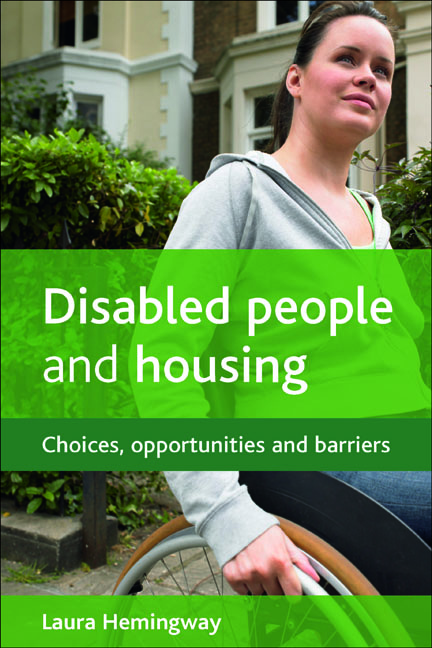Book contents
- Frontmatter
- Dedication
- Contents
- Acknowledgements
- one Introduction
- two Housing policy and disabled people: from past to present
- three Understanding disability: from ‘personal tragedy’ to social disadvantage
- four Physical and communication barriers: the built environment and access to information
- five Financial considerations: income, affordability and risk assessment
- six Attitudinal constraints: assumptions and institutional practices
- seven Creating the ‘home’ in a society of barriers
- References
- Websites
- Index
three - Understanding disability: from ‘personal tragedy’ to social disadvantage
Published online by Cambridge University Press: 07 September 2022
- Frontmatter
- Dedication
- Contents
- Acknowledgements
- one Introduction
- two Housing policy and disabled people: from past to present
- three Understanding disability: from ‘personal tragedy’ to social disadvantage
- four Physical and communication barriers: the built environment and access to information
- five Financial considerations: income, affordability and risk assessment
- six Attitudinal constraints: assumptions and institutional practices
- seven Creating the ‘home’ in a society of barriers
- References
- Websites
- Index
Summary
There has been a shift in thinking about what constitutes ‘disability’ in recent years, from restriction arising through individual functioning and based on medical interpretations, to that which is caused by social, environmental and cultural barriers. This transition from an individual or ‘medical model’ interpretation of disability to a socio-political approach has been crucial for highlighting the constraints that disabled people encounter every day of their lives, and is hugely significant for housing policy and provision. It has been argued that housing providers and policymakers, as well as those involved in the ‘disability business’ (Albrecht, 1992), have largely been influenced by the former, to the detriment of disabled people. There are, then, two key models of disability: the individualistic ‘medical’ model and the social model (there are also several variations of these; see Priestley, 1998 and later in this chapter). This chapter offers an overview of these models, and highlights how the approach taken by a person or institution can affect the treatment of disabled people and the services that they receive. With this in mind, it is essential that housing practitioners and policymakers question their understanding of disability and the impact it has on their work with disabled people, and – following a social approach to disability – need to engage in initiatives for more inclusive practices that challenge disabling social processes.
Individual understandings of disability: personal disadvantage?
The more individualistic understanding of disability and impairment, often referred to as the ‘medical model’ or ‘personal tragedy’ approach, began to emerge in the 19th century, alongside the rise of institutionalised forms of housing and the increasing influence of medical professionals. As mentioned in Chapter One, the model is based on the premise that an individual has an impairment or ‘functional limitation’ that prevents them from doing something (Oliver, 1990a, 1996a).
- Type
- Chapter
- Information
- Disabled People and HousingChoices, Opportunities and Barriers, pp. 51 - 66Publisher: Bristol University PressPrint publication year: 2011

